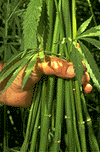DESCRIPTION
HEMP
Common name for a tall annual herb ( Cannabis sativa ) of
the family Cannabinaceae, native to Asia but now widespread because of its
formerly large-scale cultivation for the bast fiber (also called hemp) and
for the drugs it yields. Known and cultivated in ancient China, the plant
was introduced into Europe before the Christian era. In the United States
it was cultivated chiefly in the Midwest.
The fiber, retted from the stem, was one of the most important for various kinds of cordage; it was also used in making paper, cloth (canvas and other kinds), oakum for calking ships, and other products. The male and female flowers are borne on separate plants. The chemical derived from the female flowering tops is used medicinally and is the source of marijuana and hashish . Hemp seed is used as bird food, and the oil from the seeds is used in the manufacture of paints, varnishes, and soap. The dried leaves are used in Asia for a beverage. The word hemp is used in combination for several other kinds of fiber plants, notably Manila hemp and sisal hemp . The true hemp plant is related to the hop , which is used in making beer. Hemp is classified in the division Magnoliophyta , class Magnoliopsida, order Urticales, family Cannabinaceae.
http://www.encyclopedia.com/html/h1/hemp.asp
Extracted from Columbia Encyclopedia, Sixth Edition, Copyright (c) 2005

HEMP
PLANT
 The
hemp plant is harvested for its fibers, seed, seed meal and seed oil.
Hemp is a distinct variety of the plant species cannabis sativa L. Due
to the similar leaf shape, hemp is frequently confused with marijuana.
Although both plants are from the species cannabis, hemp contains virtually
no THC (delta-9-tetrahydrocannabinol), the active ingredient in marijuana.
The
hemp plant is harvested for its fibers, seed, seed meal and seed oil.
Hemp is a distinct variety of the plant species cannabis sativa L. Due
to the similar leaf shape, hemp is frequently confused with marijuana.
Although both plants are from the species cannabis, hemp contains virtually
no THC (delta-9-tetrahydrocannabinol), the active ingredient in marijuana.
Hemp cannot be used as a drug because it produces virtually no THC (less than 1%), where marijuana produces between 5 - 20 % THC.
http://www.naihc.org/hemp_information/hemp_defined.html
Information from the North American Industrial Hemp Council






